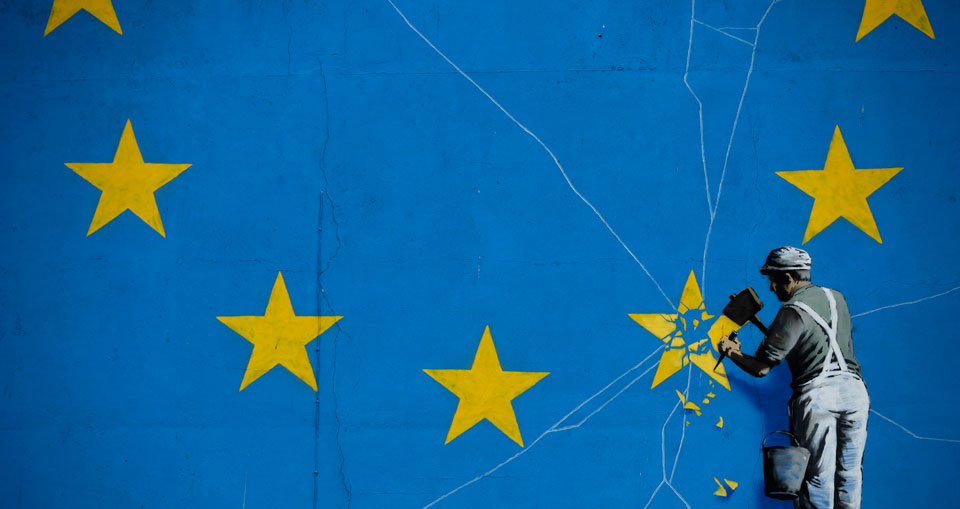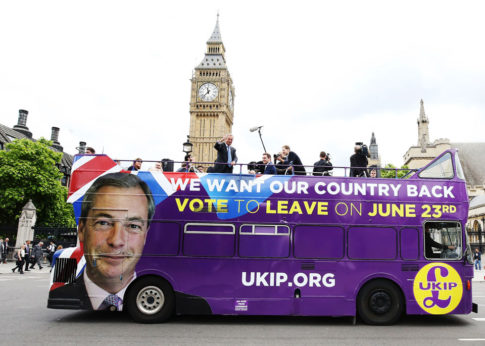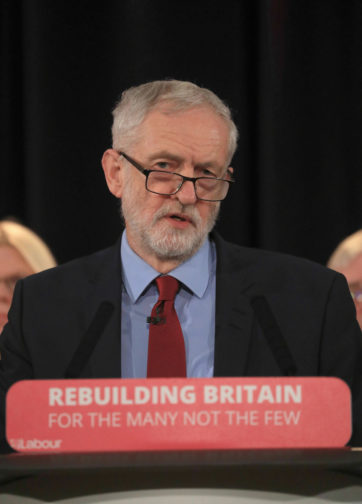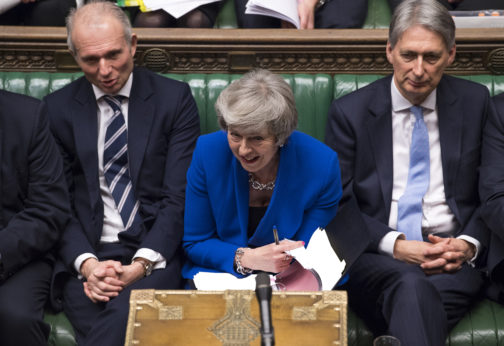
In 2016, British voters opted to get out of the European Union. After more than two years of (failed) negotiations, the Brexit deadline is now looming, with the UK set to leave the single European market on March 29, 2019. In March and April, People’s World correspondent Al Neal will be on the scene in Britain and Europe to cover events as they unfold. With everyone talking about Brexit, here’s a guide to some of the big questions involved—including what the EU actually is, who in Britain wanted to get out and why, and how the left across Europe is reacting.
To start with, what is the EU?
The European Union is an economic and political partnership between 28 countries, created after World War II to foster economic cooperation. The idea put forward at the time was that the more countries trade together, the less likely they will go to war. After decades of increasing integration, it has now become a single market where people and goods move freely, acting as if EU member states were one country.
Sounds good, right?
The truth is that the EU, originally called the European Coal and Steel Community (ECSC), was a part of efforts to jumpstart capitalist redevelopment in the 1950s. The war had destroyed European capitalism, the Soviet Union’s influence was expanding, and Communists and Social Democrats were advancing in elections all over Western Europe.

The U.S. sponsored such agreements as the ECSC, combined with more overt military efforts like the establishment of NATO.
For forty years, the increasing integration of the economies and militaries of Western Europe served to secure capitalism. After the fall of the Soviet Union and the socialist countries of Eastern Europe in the early 1990s, the EU expanded its borders and along with them, the reach and intensity of capitalist exploitation.
The European Union was established under its current name in 1993, two years after the formal end of Soviet socialism, following the Maastricht Treaty. The agreement established the basis for a common European currency, with Germany’s Bundesbank effectively in charge of it. The conditions of the new treaty established tight budget rules on all member states meant to contain any moves deemed too left-wing: Budget deficits must be capped at three percent, and government debt can never pass 60 percent of GDP. The enforcer of these rules: the European Central Bank—dominated by Germany.
More than just a “trade organization,” the EU today acts as bank, judicial system, economic enforcer, and watchdog military alliance.
So the British want to leave?
UK voters opted to leave the European Union by referendum in June 2016, 51.9 percent to 48.1 percent. Turnout was 71.8 percent, with more than 30 million people voting.
Who wanted to leave?
The UK Independence Party (UKIP), the right-wing Northern Ireland-based Democratic Unionist Party, half of the Conservative Party, and a few Labour Party MPs. All argued Britain was being held back by the EU, which they said imposed too many rules on business and charged billions of pounds a year in membership fees for little in return.
At the forefront of the “Leave” campaign was UKIP, led by far-right extremist Nigel Farage, well known for his anti-immigrant rhetoric. The campaign for Brexit relied on fear tactics and misleading messaging—very similar to then U.S. presidential candidate Donald Trump’s rhetoric.
A low (and tipping) point came in the form of a poster showing thousands of refugees crossing the Croatia-Slovenia border, with the words: “BREAKING POINT: We must break free of the EU and take back control of our borders.”
Farage went so far as to claim women could be “at risk of mass sex attacks carried out by gangs of migrant men if Britain stays in the EU.”
After a year of such hysteria, the public’s perception of asylum seekers, and immigrants generally, soured—helped along by the right-wing British media after the 2015 Paris attack).
Nearly 75 percent of prospective Leave voters cited immigration as the most important issue determining their vote.
Was Brexit really a “working-class” (or any “class”) revolt?
Taken at face value, it could be argued Britain’s working class was responsible for Brexit’s success—just as some argue that America’s working class put Trump in the White House.
It’s been pointed out that what Hell’s Angels writer Hunter S. Thompson called an “ethic of total retaliation” against changing socioeconomic and political landscapes has been a key component used by extremist parties globally to court the votes of those who feel left out or worried about their diminishing superiority in vastly changed world.. For some Brexit supporters, like Trump voters in the U.S., this translated into a sense that if you can’t win in the system anymore, then burn the whole thing down.
The reality, of course, is a bit more nuanced.
Both the working class and capitalist class split their votes across traditional party lines with conventional left vs. right politics unable to explain the results.
According to the class categories used by pollsters, as debatable as they are, the working class made up a quarter of the Brexit vote—a bit less than half of the 31 of the population that voted Leave. Enough to tip the vote, but not much more.
Based on all available data, the Leave vote was not more popular among low-skilled, or tradecraft workers, but rather with the intermediate level, which sees its socioeconomic position as declining.
The “upper” class, joined by portions of the “middle” class, made up nearly 60 percent of the Leave vote. A London School of Economics analysis found the Leave vote to be an “associated with middle class identification and the more neutral ‘no class’ identification.” It actually found no evidence of a direct link with working-class identification.

The clearest lines of separation were between race and generation. Those under 34 overwhelmingly voted Remain, while the 55-65 year-olds tilted in the opposite direction. As for race, 53 percent of the Leave vote came from white British voters, while 65 percent of Remain voters identified as “other” British ethnicities.
Those who work in London’s finance sector overwhelmingly voted Remain, hoping of course to maintain their position as an international capital of finance competing with New York as well as their dominance in the EU’s single market.
Where does the Labour Party stand?
Labour, under left-wing leader Jeremy Corbyn, accepts the referendum results but opposes the deal(s) that Conservative Prime Minister Theresa May has crafted.
The party says it wants a close relationship with the EU, but also to protect British workers’ rights and environmental standards. It calls May’s approach, which has sidelined Parliament in negotiations with the EU, “reckless.”
But even internally, the Labour Party is not unanimous on the question.
The centrist “New Labour” faction that controlled the party under former Prime Ministers Tony Blair and Gordon Brown supported Britain remaining in the single European market. This was the same group who in the 1980s and ’90s had pulled the Labour Party to the right in an effort to compete with the Conservatives under Margaret Thatcher.
Those identified with the so-called “old” Labour Party rooted of the 1970s were against European integration, viewing it as “an international capitalist scheme to defang the welfare state, erode pro-labor regulations, and more.”
Tony Benn, perhaps the most well-known left-winger in the party’s recent history, had said as far back as 1975 that integration with Europe would mean “the end of Britain as a completely self-governing nation and the end of our democratically elected parliament….”
A fair number of Labour members today still harbor the kind of skepticism expressed by Benn decades ago, and this “old Labour” tradition is the same one that current party leader Jeremy Corbyn hails from.
Despite these divisions, Remain prevailed as Labour’s official stance in 2016, thought Corbyn never seemed to exert a terrible amount of effort on behalf of the position.
Following the Brexit vote, his lukewarm support for the Remain option led to a move by centrist elements to unseat him from the party leadership. The effort failed, and in January 2017, Corbyn announced he would push his party’s MPs to vote to trigger Britain’s formal withdrawal from the EU.
Where does the Communist Party of Britain stand?
The Communist Party also stands opposed to the deals that May has been negotiating. It argues for an immediate general election to remove the Conservatives from office and replace them with a left-led Labour government. The party firmly supports sticking to the March 29 date for Britain to leave the EU.
“At the root of the crisis is the vote by a people’s and working-class majority in June 2016 against membership of the European Union, whereas powerful sections of the ruling capitalist class want continued alignment with the pro-big business rules of the EU Single Market and Customs Union,” party general secretary Robert Griffiths has argued.
“In any event, the aim will be the same: to maintain Britain’s subjection to pro-big business EU rules that would obstruct the policies of a future left-led Labour government.”
What is “Lexit”?
Lexit, or “Left Exit,” is the campaign for a left-oriented exit from the Eurozone and from the currently prevailing neoliberal integration. The key argument is that the only way to effectively fight neoliberalism and uphold democracy in Europe now is to get out of the EU’s un-reformable institutions.. It’s a position backed by the Communist Party.
Lexit’s main points:
— Leaving the single-market will allow a Labour government to end austerity.
— The single-market undermines public ownership and restricts the UK government from providing support to industries.
— The single-market prevents the UK government from nationalizing railways and other key industries.
— Whatever workers’ rights exist in the EU are being eroded, placing workers at risk. The “social Europe” promised years ago never materialized.
Where does organized labor stand?
The UK’s Trades Union Congress (the equivalent to the AFL-CIO in the U.S.) opposed Brexit, urging union members to vote Remain. Most union leaders argued that the social and cultural benefits of being in the EU outweighed the advantages of leaving, but still argued for a more “social Europe.”
One big exception was the National Union of Rail, Maritime, and Transport Workers (RMT). The RMT urged members to vote in favor of Brexit, saying “it’s a myth that the EU is in favor of workers.” The issue again is the validity and strength of labor laws and workers’ rights created under the EU’s single market. Read our earlier coverage here.
Where does the rest of Europe’s left stand on the EU?
As with the UK left, European leftists are split on membership. All major leftist parties have grievances against the EU, but none have a clear solution for how to address the issues, or ultimately, how to leave.
Two perfect examples of this divide come from Portugal and Belgium:
“Many are those who correctly warn about the dangers of xenophobia and of the far-right, and they correctly make speeches about the neo-fascism of Trump in the USA. But some of them are the same who hide the socioeconomic and political causes of the rise of the far right,” says Jerónimo de Sousa, the general secretary of the Portuguese Communist Party (PCP).
He adds: “The economic, social, and political instability in Europe has deep causes, and these come from the dominant system and its instruments, such as the European Union.”
On the other side, the Workers Party of Belgium takes a vastly different stance:
“We oppose the austerity measures the EU forces on poorer countries and even on more developed countries like ours,” Benjamin Pestieu, a party leader said. “We oppose militarism and the war-mongering done by NATO, but we cannot align ourselves with the far right and take the xenophobic, go-it-alone approach they push. We cannot align ourselves with those people.”
The reason for these differences often has to do with the uneven effects EU policies have on the individual economies but also with political assessments made by the left parties themselves.
Following the 2008 economic meltdown, EU states found out just what they had signed on for: draconian austerity measures, the widespread privatization of state-owned enterprises, and emigration. Millions of mainly young Portuguese, Irish, Greeks, and Spaniards fled abroad in search of better economic opportunities.
Poorer European countries, such as Greece, were hit particularly hard by EU-imposed austerity and the departure of workers. As noted by Communist Party of Greece member Maria Antonopoulou: “The basic goal [of austerity] is to buttress the competitiveness of the monopoly groups in order to…ensure cheaper labor power.”
Of course, on the flip-side, there are Marxist arguments for staying in and reforming the EU. Former Greek Finance Minister Yanis Varoufakis argues that there are positives from having a transnational single market for workers. Capital is not the only force able to cross borders; workers’ mobility means they can chase higher wages and put pressure on employers. He quotes Karl Marx on the need for capitalism to reach its highest international development in order to open the path to socialism.
Leaving the EU, Varoufakis says, would be a backward move economically and would abandon the advances for workers’ rights made so far. Further, he argues that leaving effectively endorses racism by supporting measures that would lock workers (particularly those from poorer countries) in place while still leaving capital free to roam.
Back to Britain, why is the Irish border a big Brexit issue?
With the 1998 Belfast Agreement (Good Friday Agreement) bringing peace between independent Ireland and the UK’s Northern Ireland, the need for a hard border and border checks was done away with.
If the UK leaves the EU while Ireland stays in, the concern is that a return of customs officials or inspectors would stop people traveling freely across the open border and that it would lead to potential violence.
Neither the UK nor EU want a hard border in Ireland, but they can’t agree on a plan to achieve it. Here’s a full breakdown of the border issue by the Irish Times.
What about Scotland?
Scotland’s First Minister Nicola Sturgeon said the result of the Leave vote was “democratically unacceptable.” The majority of Scots voted to remain in the EU.
Her Scottish National Party (SNP) has called for an extension of the Brexit transition period, to give more time to negotiations on an acceptable deal. The SNP leader wants to stay in the customs union and single market after Brexit, describing it as the “least damaging” option for the UK economy.

The Scotsman reports the SNP will work with other parties in the House of Commons (Parliament) to try and force Article 50 to either be revoked or extended.
The Brexit issue has highlighted the case for another Scottish independence vote and has split the major leftist parties on whether to leave or stay.
What’s the difference between a “soft” and “hard” Brexit?
A “hard” Brexit could be the UK government refusing to compromise on issues of free movement of people even if it meant leaving the single market or having to give up hopes on future free trade agreements.
A “soft” Brexit would see the UK leave the EU and join the European Economic Area (EEA) and the European Free Trade Association (EFTA), which would allow for full access to the EU single market but would require the UK to follow the EU’s single market rules. Norway is a good example of a “soft” EU withdrawal.
It would effectively be a sort of associate member status, leaving investors and banks free to operate in Europe as they have done, but placing new limits on workers moving in and out of Britain.
What will Brexit do to the UK economy?
A summary from the London School of Economics (LSE), analyzing several economic projection models of Brexit, found that there will be a long-term loss of GDP for the UK economy compared to the status quo projections of remaining part of the EU and its single market.
“The range of estimates is large, from a loss of GDP of nearly ten percentage points to a gain of four points.”










